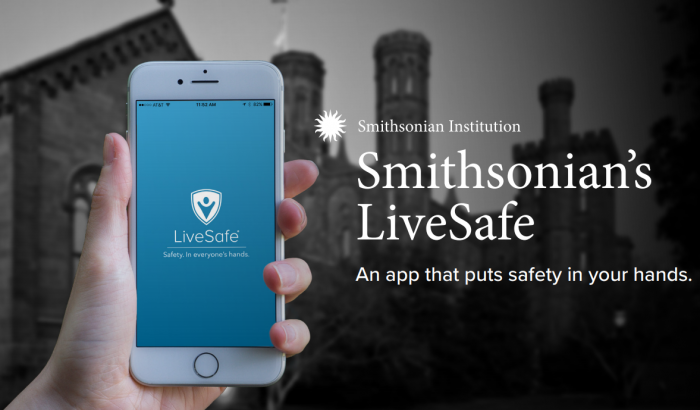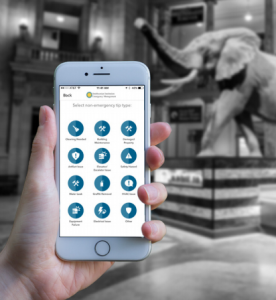Be smart. LiveSafe.
Before you download another game on your phone, take your safety into your own hands with our free app.

Not everyone spends their day sitting at a computer, but almost all of us carry a computer in our pocket or purse everywhere we go. By using the power of our smart phones, the Smithsonian’s Office of Emergency Management is working to make the Smithsonian a safer place for everyone.
Anyone with access to OEM’s PRISM homepage can download LiveSafe, a free app for iOS and Android mobile phones that is tailored to the different regions where SI staff work.
Download and install LiveSafe on your phone and you will have direct contact with the Smithsonian Communications Center located on the ground floor of the Natural Museum of Natural History. This collaborative communications system will send its users all emergency alerts issued by the Smithsonian to the region where they work. In addition, users can quickly report emergencies to OEM and the Office of Facilities Management and Reliability, as well as non-emergency hazards, such as broken water pipes and slippery walkways.
“The LiveSafe app is the Smithsonian’s primary means of emergency alert notification,” explains Floyd HeHe, chief of OEM’s Smithsonian Communications Center. “Currently, 914 constituents have downloaded the LiveSafe system and I am constantly out beating the drum to get more people to sign up.”
With each new download the LiveSafe system becomes that much stronger and more effective.
“Two and a half years ago, OEM Director of Emergency Management Eric Gentry and Emergency Management Specialist Ramon Davis began working to develop a strong and effective set of emergency procedures and protocols for the Smithsonian’s units and staff to take in an emergency,” Hehe says. “LiveSafe is the key communications tool OEM uses to let staff know when something is happening, take action and put those emergency procedures in place.”
LiveSafe alerts staff to three different types of events:
- Natural hazards, such as weather related emergencies;
- Environmental like fires, hazardous waste spills and gas leaks inside a building; and
- Security “We do the reporting on security hazards, but collaborate with the Office of Protection Services to supply all of the information we release,” HeHe explains.
 When you install LiveSafe on your phone, the app gives you the option to choose which Smithsonian regional alerts you want to receive the National Capital Region; New York City; Ft. Pierce, Fla.; Udvar-Hazy Center/Herndon, Va.; Front Royal, Va.; Cambridge, Mass.; Edgewater, Md.and the Republic of Panama.
When you install LiveSafe on your phone, the app gives you the option to choose which Smithsonian regional alerts you want to receive the National Capital Region; New York City; Ft. Pierce, Fla.; Udvar-Hazy Center/Herndon, Va.; Front Royal, Va.; Cambridge, Mass.; Edgewater, Md.and the Republic of Panama.
Users can choose to receive alerts for more than one region.
Smithsonian Emergency Management staff will only push through LiveSafe alerts that are deemed critical. The modes of contact, which may include e-mail, text message, and/or push notification, will depend on the severity and potential impact of the hazard.
Hehe stresses that the Smithsonian’s contractual arrangement with LiveSafe does not allow the company to track individual users or use the data collected from the Smithsonian for any purpose.
“Even the staff of the Emergency Management Office do not have the ability to track an individual using the LiveSafe app,” Hehe adds. “If you’re ever in trouble, LiveSafe will allow you to send a message for help and communicate your location to the SCC.”
The LiveSafe app features both voice and chat capabilities. Other safety features include:
- A safety map that uses GPS to safely guide you to the nearest police station, fire department, or medical facility;
- A SafeWalk function that uses GPS to let another user follow you on a map, talk to you and make sure you get safely to where you are going; and
- Access to emergency procedures so you will know exactly what to do in an emergency.
To learn more about LiveSafe and download the app, visit the Office of Emergency Management’s webpage on Prism at: http://prism2.si.edu/SF/oem/Pages/livesafe.aspx
Posted: 11 March 2019
- Categories:






